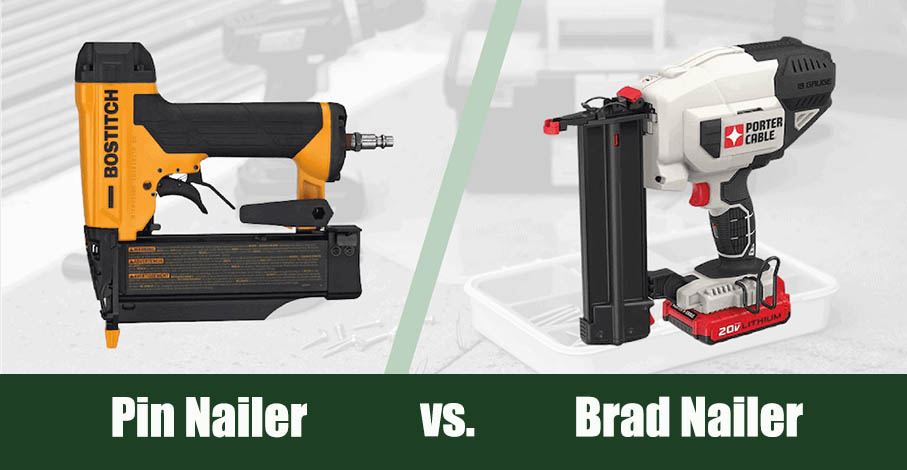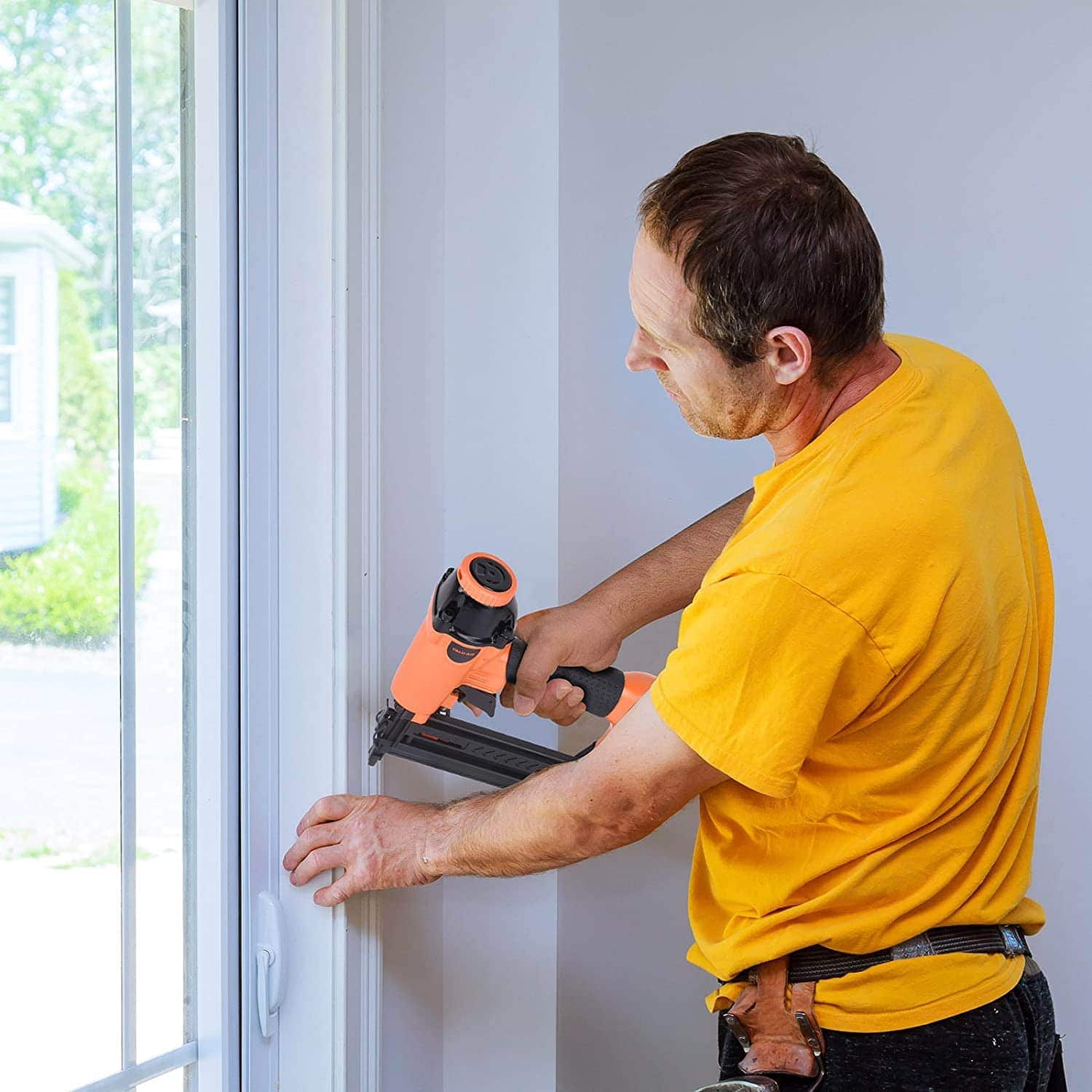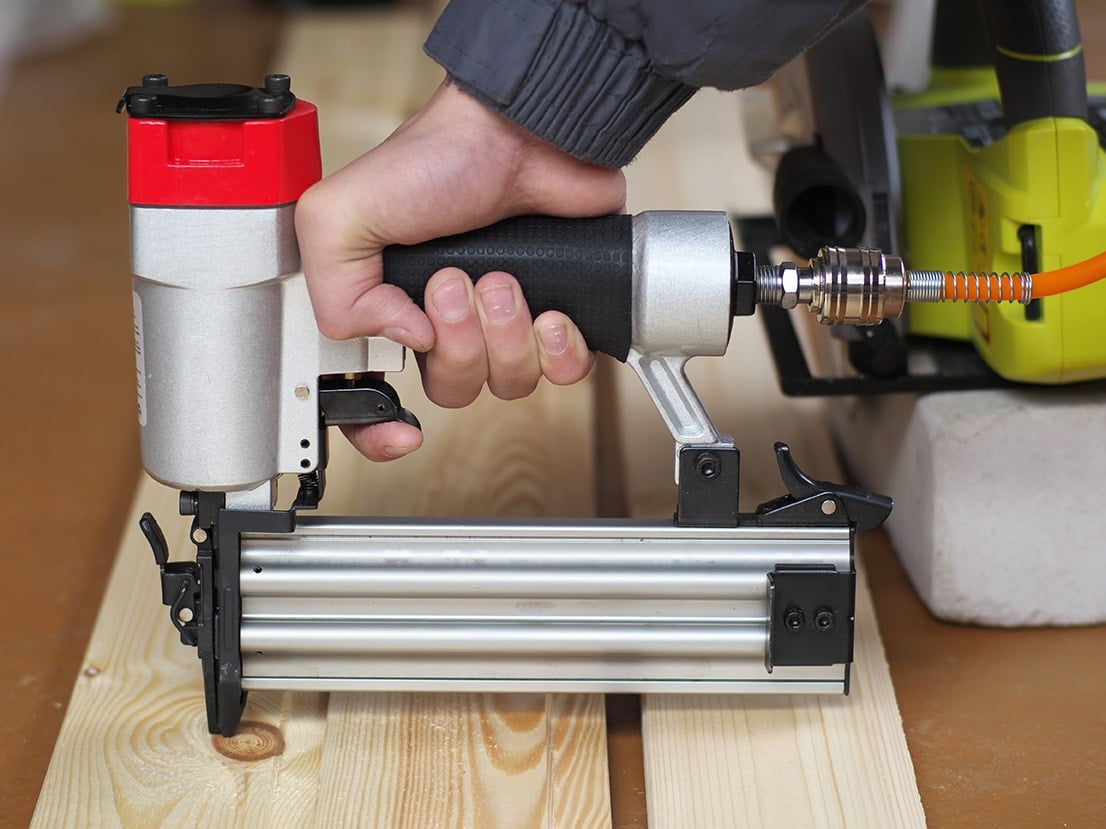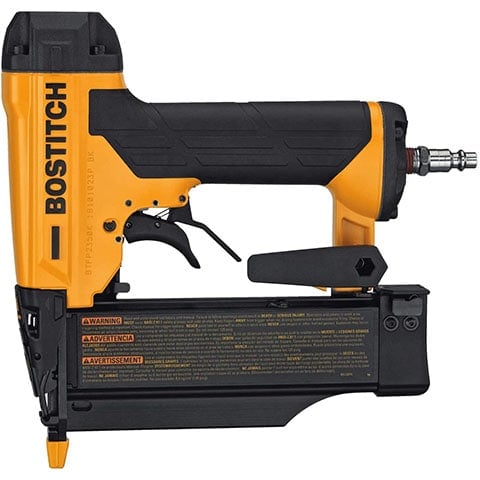Pin Nailer vs Brad Nailer: Which is Best for Your Needs?
-
- Last updated:


You’re starting a new project and realize that you’re in need of a finish nailer. After careful deliberation, you’ve decided that you need something smaller than a 16-gauge finish nail, but that still leaves two options: a pin nailer or a brad nailer.
Both seem like pretty similar tools. They sink small finish nails into wood, so does it even matter which one you get? Truthfully, yes. While they perform similar functions, the nails they sink do not, and the nails separate the two devices.
It’s vital that you get the right tool for the job, so let’s take a closer look at each of these machines and determine which one will be the best fit for your needs.

Overview of Pin Nailer
At its core, a pin nailer is just a nail gun that shoots very tiny nails. In most respects, it is just like any other nail gun. They’re generally pneumatic, so you have to hook it up to an air compressor.
You insert a rack of nails into the machine, press the tip of the nail gun into the material, and pull the trigger. The nail is driven just below the surface of the wood so that it’s not sticking out, and you can adjust the depth with the depth control. It differs from other nail guns in the pin nails that it shoots.

What’s Special About Pin Nails?
Pin nailers shoot the smallest finishing nails. The nails are so small that they’re called pins. Pin nails are 23-gauge, and they’re available in headless and slight-headed varieties.
The advantage of pin nails is that they leave such a tiny hole that they will usually disappear into the grain of the wood. Other finish nails leave holes large enough that you’d need to plug them with a filler, such as putty, caulk, or wood filler.
The other advantage to the tiny 23-gauge nails that a pin nailer shoots is that they won’t split your wood. Especially when working with delicate pieces of trim, a regular finish nail might cause the wood to split, while a pin nail is almost guaranteed not to.
Where Pins Win
Pin nails are the obvious choice when working with small or delicate wood, like fine furniture trim. Pin nails are also an excellent choice for working with veneers. They’re the go-to option when you’re gluing two wooden pieces together, and you need a way to anchor them until the glue dries.
One Trick Pony
The problem with pin nails is that they aren’t versatile. Because they’re so small and generally headless, they have very little holding power. If you need to hold on to the trim or a baseboard, pin nails aren’t going to do the trick. Truthfully, there are only a few uses for pin nailers, which makes them specialty tools.
- Available headless or slight-headed
- The hole is so small it can disappear in paint
- Tiny pin nails won’t split wood
- Minimal holding strength
- You’ll need glue to hold pin nails
- Only has a few specific uses

Overview of Brad Nailer
Brad nail guns are essentially the middle option when it comes to finishing nailers. The brad nails they shoot are smaller than 15 and 16-gauge finish nailers but much larger than the tiny pin nails that a pin nailer shoots.
These machines function like any other nailer, but they’re more versatile than other designs. Most are pneumatic, but because of their popularity, several manufacturers now offer battery-powered models.

What Are Brad Nails?
Brad nails are 18-gauge, which provides decent holding power while still being small enough that the holes left are tiny. Granted, they’re still much larger than the holes a pin nail leaves. You’ll see the holes, so if you’re looking for finish-quality work, you’ll need to go back and fill the holes in.
Is There Anywhere You Can’t Use a Brad Nail?
Because brad nails are a good compromise between the larger 16-gauge finish nails and the tiny 23-gauge pins, they can be used anywhere you need a finishing nail. They’re great for standard trim work and will even work well for installing baseboards. You can use a brad nailer for crown molding, building cabinets, furniture, and much more. There are few times when a brad nail won’t do the job.
When You Wouldn’t Use a Brad Nailer
You don’t want to use a brad nail when working with the smallest, most delicate trim. There’s a chance that the 18-gauge nail will split the wood when a 23-gauge pin wouldn’t. Likewise, the hole from the brad nail’s head leaves a noticeable mark that needs to be filled.
- Decent holding power for small trim
- Very versatile tool with many applications
- Leaves a small hole
- Could potentially split your wood
Is a Brad Nailer or Pin Nailer Better?
It is hard to state that either tool is better. Brad nailers have decent holding power and are great for many situations, but they also leave holes in the wood and can split delicate pieces. Pin nailers, on the other hand, leave holes so small you can hardly tell, and they’ll never split your wood, but they have practically no holding power and very specialized uses.
Ideally, you’d want to have both to use each one when it is the best option. But not everyone has that luxury, and some DIYers don’t need both. It would be pointless to purchase a tool that you never use, so let’s see if we can boil this choice down to a single deciding factor that might simplify things.
A Question of Versatility
If we were to pick just one trait and say it was most important, it would have to be versatility. A tool that’s not versatile will sit on your shelf for most of its life, waiting for the right time to be used.
However, a multifaceted tool can complete several projects. In this category, the brad nailer wins, hands down. Pin nailers have only a few uses. Brad nailers can be used pretty much anywhere you need a finish nailer. They’re an excellent option for times that you’d typically use a 16 or 15-gauge nail, and they’ll even work for times you need a tiny nail for fine finish work.
Which One Should You Choose?
If you intend to use your nailer for fine finish work on furniture trim, veneers, and wooden models, or you just need to hold two pieces together while the glue dries, a pin nailer is the way to go. They are great if you only work with very delicate pieces of wood that don’t require much holding power.
For all other applications, a brad nailer is generally the better choice. Brad nails will give you better-holding power, allowing you to install trim, baseboard, crown molding, and more. The nails leave a small hole from the head, but since they’re only 18-gauge, the hole is barely visible and can always be filled after.
- Delicate furniture trim
- Thin veneers
- Holding two small wooden pieces together while glue dries
- When you can’t risk splitting a delicate piece
- When you don’t want a visible hole from a nail head
- Baseboard
- Standard trim work
- Crown molding
- When you need more holding power than a pin can offer
- When you can cover the nail holes with caulk, putty, or filler
Quick Look: Our Top Choices
| Image | Product | Details | |
|---|---|---|---|
Our Favorite Pin Nailer
 |
BOSTITCH Pin Nailer |
|
CHECK PRICE |
Our Favorite Brad Nailer
 |
PORTER-CABLE 20V MAX Cordless Brad Nailer Kit |
|
CHECK PRICE |
Our Favorite Pin Nailer: BOSTITCH Pin Nailer

If you need to drive 23-gauge pin nails, this Bostitch Pin Nailer is the tool we’d recommend. Unlike many pin nailers that top out at 1-inch pins, the Bostitch can shoot pin nails up to 2 inches long.
It can easily shoot nails into hardwoods like oak and features a tool-free depth adjustment to easily control the depth. Oil-free operation means there’s very little chance of staining your work, and the tool-free jam release makes it easy to get back to work if the gun jams.
Our Favorite Brad Nailer: PORTER-CABLE 20V MAX Cordless Brad Nailer Kit

Forget all those heavy, loud air compressors and miles of air hose just to sink a few finish nails. The PORTER-CABLE 20V MAX Cordless Brad Nailer ends all that with battery-powered convenience that lets you sink finishing nails faster than ever before. You can set the depth adjustment without any tools, just like the jam release that ensures you never waste time fiddling with annoying jams.
The kit includes the gun, a battery, and a charger, so you have everything you need to get rolling. To top it all off, a 3-year limited warranty protects the nailer, so your investment will be around to help you complete many projects.

Conclusion
Nail guns have revolutionized the construction industry by increasing productivity. Both pin nailers and brad nailers are valuable tools that, while similar, have separate uses. Often, you can use either, but the pin nailer will be better for you if you’re planning to glue the pieces in addition to nailing, while the brad nailer is better for when you’re not going to be gluing at all.
Related Reads:
- Ryobi Air Strike P320 Brad Nailer Review
- Crown Stapler vs Brad Nailer: Which is Best for Your Project?
- Siding Nailer vs Roofing Nailer: Which is Best for Your Needs?
- Brad Nailer vs Finish Nailer: Which is Best for Your Needs?
Contents

